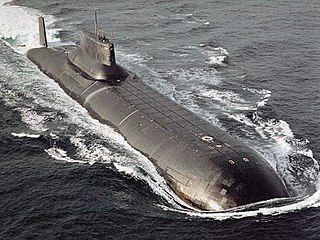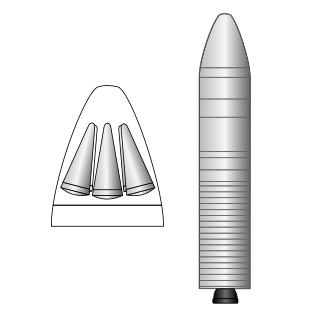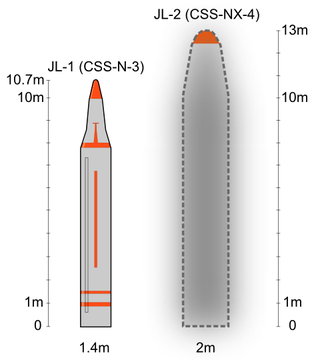Related Research Articles

A submarine-launched ballistic missile (SLBM) is a ballistic missile capable of being launched from submarines. Modern variants usually deliver multiple independently targetable reentry vehicles (MIRVs), each of which carries a nuclear warhead and allows a single launched missile to strike several targets. Submarine-launched ballistic missiles operate in a different way from submarine-launched cruise missiles.

The R-39 Rif was a submarine-launched ballistic missile (SLBM) that served with the Soviet Navy from its introduction in 1983 until 1991, after which it served with the Russian Navy until 2004. The missile had GRAU indices of 3M65, 3M20, and 3R65. It was carried on board Typhoon-class submarines.

The Typhoon class, Soviet designation Project 941 Akula, is a class of nuclear-powered ballistic missile submarines designed and built by the Soviet Union for the Soviet Navy. With a submerged displacement of 48,000 tonnes, the Typhoons are the largest submarines ever built, able to accommodate comfortable living facilities for the crew of 160 when submerged for months on end. The source of the NATO reporting name remains unclear, although it is often claimed to be related to the use of the word "typhoon" ("тайфун") by General Secretary Leonid Brezhnev of the Communist Party in a 1974 speech while describing a new type of nuclear ballistic missile submarine, as a reaction to the United States Navy's new Ohio-class submarine.

The M45 SLBM was a French Navy submarine-launched ballistic missile Forty-eight M45 were in commission in the Force océanique stratégique, the submarine nuclear deterrent component of the French Navy. The missiles, derived from the M4, were produced by Aérospatiale. Initially, an ICBM land-based version was considered, but these plans were discarded in 1996 to favour an all-naval deployment.

The M51 SLBM is a French submarine-launched ballistic missile, built by ArianeGroup, and deployed with the French Navy. Designed to replace the M45 SLBM, it was first deployed in 2010.
R-29 Vysota Р-29 Высота is a family of Soviet submarine-launched ballistic missiles, designed by Makeyev Rocket Design Bureau. All variants use astro-inertial guidance systems.

The Delta class, Soviet designations Project 667B Murena, Project 667BD Murena-M, Project 667BDR Kalmar, Project 667BDRM Delfin, are a series of nuclear-powered ballistic missile submarines, designed and built in the Soviet Union, which formed the backbone of the Soviet and Russian strategic submarine fleet since their introduction in 1973. They carry nuclear ballistic missiles of the R-29 Vysota family, with the Delta I, Delta II, Delta III and Delta IV classes carrying the R-29, R-29D, R-29R and R-29RM respectively. The Delta I class carried 12 missiles, while the Delta II class which are lengthened versions of the Delta I class carry 16 missiles. The Delta III and Delta IV classes carry 16 missiles with multiple warheads and have improved electronics and noise reduction. 34 boats were built and commissioned during 1972–1990; approximately five or six remain active in 2023.

The JL-2 is a Chinese second-generation intercontinental-range submarine-launched ballistic missile (SLBM) deployed on the People's Liberation Army Navy's (PLAN) Type 094 submarines. It succeeds the JL-1 SLBM deployed on the Type 092 submarine.

The R-29RM Shtil was a liquid propellant, submarine-launched ballistic missile in use by the Russian Navy. It had the alternate Russian designations RSM-54 and GRAU index 3M27. It was designed to be launched from the Delta IV submarine, each of which is capable of carrying 16 missiles. The R-29RM could carry four 100 kiloton warheads and had a range of about 8,500 kilometres (5,300 mi). They were replaced with the newer R-29RMU2 Sineva and later with the enhanced variant R-29RMU2.1 Layner.

The RSM-56 Bulava is a submarine-launched ballistic missile (SLBM) developed for the Russian Navy and deployed in 2013 on the new Borei class of ballistic missile nuclear submarines. It is intended as the future cornerstone of Russia's nuclear triad, and is the most expensive weapons project in the country. The weapon takes its name from bulava, a Russian word for mace.

The Borei class, alternate transliteration Borey, Russian designation Project 955 Borei and Project 955A Borei-A, are a series of nuclear-powered ballistic missile submarines being constructed by Sevmash for the Russian Navy. The class is projected to replace the Soviet-era Delta III, Delta IV and Typhoon classes in Russian Navy service.

Kura Missile Test Range, originally known as Kama, is a Russian intercontinental ballistic missile impact area located in northern Kamchatka Krai in the Russian Far East. It is the destination for ballistic missiles which are test fired from other centers, and was chosen due to its remoteness and distance. It is 130 kilometers (81 mi) northeast of the settlement of Klyuchi and the military townlet is called Klyuchi-1, after the nearest settlement.

K-535 Yuriy Dolgorukiy is a Borei-class nuclear-powered ballistic missile submarine of the Russian Navy, and the lead vessel of the class. Named after the founder of Moscow, Yuri Dolgorukiy, the vessel was laid down on 2 November 1996 and was first planned to enter service in 2001. However, project for the R-39M SLBM that the Borei class was supposed to carry was abandoned after several failed tests, and the submarine was redesigned for the new RSM-56 Bulava SLBM. The RSM-56 Bulava is smaller than the original R-39M, and in the 2007 START treaty data exchange it was reported that all Borei-class submarines would be equipped with 16 missiles instead of 12, as originally intended.

The Julang-1 was China's first generation nuclear submarine-launched ballistic missile (SLBM). According to a US Department of Defense report in 2011, the operational status of the JL-1 was "questionable".

The R-29RMU2 Sineva, code RSM-54, is a Russian liquid-fueled submarine-launched ballistic missile with GRAU index 3M27, designation SS-N-23A Skiff. It can carry four warheads and is designed to be launched from Delta IV-class submarines, which are armed with 16 missiles each. As of 2017, there are 96 launchers deployed on the submarines.

The K family of missiles, is a family of submarine-launched ballistic missiles (SLBM) developed by India to boost its second strike abilities and thus augment its nuclear deterrence. Information about this family of missiles has mostly been kept classified. It is reported that 'K missiles' are faster, lighter and stealthier than their Agni missile counterparts. High Energy Materials Research Laboratory (HEMRL) developed a new formulation of composite propellant that is more efficient and provide greater thrust compare to Agni missile series. The objective behind the development is to make K missile family faster and lighter without compromising on operational range.
The R-29RMU2.1 Layner is a Russian liquid-fuelled submarine-launched ballistic missile (SLBM) and the newest member of the R-29 missile family, developed by the Makeyev Rocket Design Bureau and produced by the Krasnoyarsk Machine-Building Plant. Derived from the R-29RMU2 Sineva SLBM, the Layner can carry twelve nuclear warheads, three times as many as Sineva. It was expected to enter service with the Russian Navy's Delta IV-class submarines after a successful test programme that spanned from May to September 2011. The Russian Navy confirmed in 2014 that the system was now in use.
The Pukguksong-1 or Pukkŭksŏng-1, Bukgeukseong-1, alternatively KN-11 in intelligence communities outside North Korea, is a North Korean, two-stage submarine-launched ballistic missile (SLBM) that was successfully flight tested on 24 August 2016.
References
- ↑ UTTH means "Improved tactical and technical characteristics"